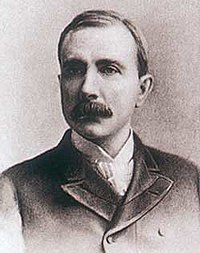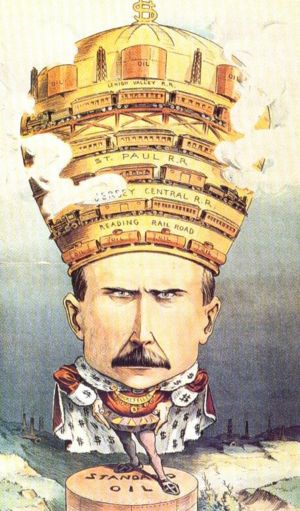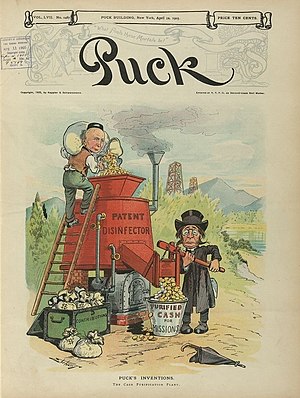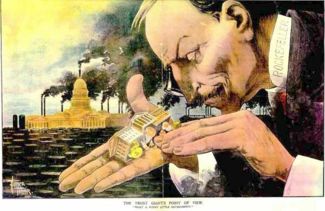John D. Rockefeller
John Davison Rockefeller, Sr. (July 8, 1839 – May 23, 1937) was an American industrialist, financier, philanthropist and founder of a powerful family of bankers and politicians. He revolutionized the oil industry and defined the structure of modern philanthropy. From childhood, Rockefeller strongly believed that his purpose in life was to make as much money as possible, and then to use it wisely to improve the lot of mankind. In 1862, Rockefeller founded the Standard Oil Company and ran it until he retired in the late 1890s. He kept his stock and as gasoline grew in importance, his wealth soared and he became the world's richest man and first billionaire.
Standard Oil was convicted in the Federal Court of monopolistic practices and broken up in 1911. Rockefeller spent the last forty years of his life creating the modern systematic approach of targeted philanthropy, creating foundations that had a major impact on medicine, education, and scientific research. His foundations pioneered the development of medical research, and was instrumental in the eradication of hookworm and yellow fever. He was a devout Northern Baptist and supported many church-based institutions throughout his life.
Always avoiding the spotlight, Rockefeller was remembered for handing dimes to those he encountered in public. Predeceased by his wife Laura Spelman Rockefeller, the Rockefellers had four daughters and one son (John D. Rockefeller, Jr.). "Junior" was largely entrusted with supervision of the foundations.
Biography
Standard Oil
In 1862 Cleveland had become established as one of the main refining centers in the U.S., and Standard was the most profitable refiner in Cleveland. When it was found out that at least part of Standard Oil's cost advantage came from secret rebates from the railroads bringing oil into Cleveland, the competing refiners insisted on getting similar rebates, and the railroads quickly complied. By then, however, Standard Oil had grown to become one of the largest shippers of oil and kerosene in the country.
The railroads were competing fiercely for traffic and, in an attempt to create a cartel to 'stabilize' freight rates, formed the South Improvement Company. Rockefeller agreed to support this cartel if they gave him preferential treatment as a high volume shipper which included not just steep rebates for his product, but also rebates for the shipment of competing products. Part of this scheme was the announcement of sharply increased freight charges. This touched off a firestorm of protest, which eventually led to the discovery of Standard Oil's part of the deal. A major New York refiner, Charles Pratt and Company, headed by Charles Pratt and Henry H. Rogers, led the opposition to this plan, and railroads soon backed off.
Undeterred, Rockefeller continued with his self-reinforcing cycle of buying competing refiners, improving the efficiency of his operations, pressing for discounts on oil shipments, undercutting his competition, and buying them out. In six weeks in 1872, Standard Oil had absorbed 22 of its 26 Cleveland competitors. Eventually, even his former antagonists, Pratt and Rogers saw the futility of continuing to compete against Standard Oil, and in 1874, they made a secret agreement with their old nemesis to be acquired. Pratt and Rogers became Rockefeller's partners. Rogers, in particular, became one of Rockefeller's key men in the formation of the Standard Oil Trust. Pratt's son, Charles Millard Pratt) became Secretary of Standard Oil.
For many of his competitors, Rockefeller had merely to show them his books so they could see what they were up against, then make them a decent offer. If they refused his offer, he told them he would run them into bankruptcy, then cheaply buy up their assets at auction. Most capitulated.
Monopoly
Standard Oil gradually gained almost complete control of all oil production in America. At that time, many legislatures had made it difficult to incorporate in one state and operate in another. As a result, Rockefeller and his partners owned separate companies across dozens of states, making their management of the whole enterprise rather unwieldy. In 1882, Rockefeller's lawyers created an innovative form of partnership to centralize their holdings, giving birth to the Standard Oil Trust. The partnership's size and wealth drew much attention. Despite improving the quality and availability of kerosene products while greatly reducing their cost to the public (the price of kerosene dropped by nearly 80% over the life of the company), Standard Oil's business practices created intense controversy. The firm was attacked by journalists and politicians throughout its existence for its monopolistic practices, giving momentum to the anti-trust movement.
One of the most effective attacks on Rockefeller and his firm was the 1904 publication of The History of the Standard Oil Company, by Ida Tarbell. Tarbell was a leading muckraker. Although her work prompted a huge backlash against the company, Tarbell claims to have been surprised at its magnitude. “I never had an animus against their size and wealth, never objected to their corporate form. I was willing that they should combine and grow as big and wealthy as they could, but only by legitimate means. But they had never played fair, and that ruined their greatness for me.” (Tarbell's father had been driven out of the oil business during the South Improvement Company affair.)
Ohio was especially vigorous in applying its state anti-trust laws, and finally forced a separation of Standard Oil of Ohio from the rest of the company in 1892, leading to the dissolution of the trust. Rockefeller continued to consolidate his oil interests as best as he could until New Jersey, in 1899, changed its incorporation laws to effectively allow a re-creation of the trust in the form of a single holding company. At its peak, Standard Oil had about 90% of the market for kerosene products.
By 1896, Rockefeller shed all of his policy involvement in the affairs of Standard Oil; however he retained his nominal title as president until 1911; he kept his stock.
In 1911, the Supreme Court of the United States held that Standard Oil, which by then still had a 64% market share, originated in illegal monopoly practices and ordered it to be broken up into 34 new companies. These included, among many others, Continental Oil, which became Conoco; Standard of Indiana, which became Amoco; Standard of California, which became Chevron; Standard of New Jersey, which became Exxon); Standard of New York, which became Mobil; and Standard of Ohio, which became Sohio. Rockefeller, who had rarely sold shares, owned stock in all of them.
Philanthropy
From his very first paycheck, Rockefeller tithed ten percent of his earnings to his church. As his wealth grew, so did his giving, primarily to educational and public health causes, but also for basic science and the arts. He was advised primarily by Frederick T. Gates after 1891, and, after 1897, also by his son.
Rockefeller believed in the Efficiency Movement, arguing that
- "To help an inefficient, ill-located, unnecessary school is a waste...it is highly probable that enough money has been squandered on unwise educational projects to have built up a national system of higher education adequate to our needs, if the money had been properly directed to that end."[1]
He and his advisors invented the conditional grant that required the recipient to "root the institution in the affections of as many people as possible who, as contributors, become personally concerned, and thereafter may be counted on to give to the institution their watchful interest and coöperation."[2]
In 1884, he provided major funding for a college in Atlanta for black women that became Spelman College (named for Rockefeller's in-laws who were ardent abolitionists before the Civil War). Rockefeller also gave considerable donations to Denison University and other Baptist colleges.
Rockefeller gave $80 million to the University of Chicago under William Rainey Harper, turning a small Baptist college into a world-class institution by 1900. He later called it "the best investment I ever made."[3] His General Education Board, founded in 1902, was established to promote education at all levels everywhere in the country. It was especially active in supporting black schools in the South. Its most dramatic impact came by funding the recommendations of the Flexner Report of 1910, which had been funded by the Carnegie Foundation for the Advancement of Teaching; it revolutionized the study of medicine in the United States.
Despite his personal preference for homeopathy, Rockefeller, on Gates's advice, became one of the first great benefactors of medical science. In 1901, he founded the Rockefeller Institute for Medical Research in New York. It changed its name to Rockefeller University in 1965, after expanding its mission to include graduate education. It claims a connection to 23 Nobel laureates. He founded the Rockefeller Sanitary Commission in 1909, an organization that eventually eradicated the hookworm disease that had long plagued the American South. The Rockefeller Foundation was created in 1913 to continue and expand the scope of the work of the Sanitary Commission, which was closed in 1915. He gave nearly $250 million to the foundation, which focused on public health, medical training, and the arts. It endowed the Johns Hopkins School of Hygiene and Public Health, the first of its kind. It built the Peking Union Medical College into a great institution, helped in World War I war relief,, and it employed William Lyon Mackenzie King of Canada to study industrial relations. Rockefeller's fourth main philanthropy, the Laura Spelman Rockefeller Memorial Foundation, created in 1918, supported work in the social studies; it was later absorbed into the Rockefeller Foundation. However, all told, Rockefeller gave away about $550 million.
Oddly enough, Rockefeller was probably best known in his later life for the practice of giving a dime to children wherever he went. He even gave dimes as a playful gesture to men like tire mogul Harvey Firestone and President Herbert Hoover. During the Great Depression, Rockefeller switched to giving nickels instead of dimes.
Legacy
He died on May 23, 1937, 26 months shy of his 100th birthday, in Ormond Beach, Florida. He was buried under a large granite obelisk in Lake View Cemetery in Cleveland, Ohio, not far from his former summer estate at Forest Hill.
Rockefeller had a long and controversial career in industry followed by a long career in philanthropy. His image is an amalgam of all of these experiences and the many ways he was viewed by his contemporaries. These contemporaries include his former competitors, many of whom were driven to ruin, but many others of whom sold out at a profit (or a profitable stake in Standard Oil, as Rockefeller often offered his shares as payment for a business), and quite a few of whom became very wealthy as managers as well as owners in Standard Oil. They also include politicians and writers, some of whom served Rockefeller's interests, and some of whom built their careers by fighting Rockefeller and the "robber barons."
Biographer Allan Nevins, answering Rockefeller's enemies, concluded:
- The rise of the Standard Oil men to great wealth was not from poverty. It was not meteor-like, but accomplished over a quarter of a century by courageous venturing in a field so risky that most large capitalists avoided it, by arduous labors, and by more sagacious and farsighted planning than had been applied to any other American industry. The oil fortunes of 1894 were not larger than steel fortunes, banking fortunes, and railroad fortunes made in similar periods. But it is the assertion that the Standard magnates gained their wealth by appropriating "the property of others" that most challenges our attention. We have abundant evidence that Rockefeller's consistent policy was to offer fair terms to competitors and to buy them out, for cash, stock, or both, at fair appraisals; we have the statement of one impartial historian that Rockefeller was decidedly "more humane toward competitors" than Carnegie; we have the conclusion of another that his wealth was "the least tainted of all the great fortunes of his day."[4]}}
Biographer Ron Chernow wrote of Rockefeller:
- What makes him problematic—and why he continues to inspire ambivalent reactions—-is that his good side was every bit as good as his bad side was bad. Seldom has history produced such a contradictory figure."[5]}}
Notwithstanding these varied aspects of his public life, Rockefeller may ultimately be remembered simply for the raw size of his wealth. In 1902, an audit showed Rockefeller was worth about $200 million—compared to the total national wealth that year of $101 billion. His wealth grew significantly after as the demand for gasoline soared, eventually reaching about $900 million, including significant interests in banking, shipping, mining, railroads, and other industries. By the time of his death in 1937, Rockefeller's remaining fortune, largely tied up in permanent family trusts, was estimated at $1.4 billion. Rockefeller's net worth over the last decades of his life would easily place him among the very wealthiest persons in history. As a percentage of the United States economy, no other American fortune—including Bill Gates or Sam Walton—ever came close.
The Rockefeller wealth, distributed as it was through a system of foundations and trusts, continued to fund family philanthropic, commercial, and, eventually, political aspirations throughout the 20th century. Grandson David Rockefeller was a leading New York banker, serving for over 20 years as CEO of Chase Manhattan (now the retail financial services arm of JP Morgan Chase). Another grandson, Nelson A. Rockefeller, was Republican governor of New York and Vice President. A third grandson, Winthrop Rockefeller, served as Republican governor of Arkansas. Great-grandson, Jay Rockefeller (John D. Rockefeller IV) is currently a Democratic Senator from West Virginia.
Rockefeller has passed into popular culture as the embodiment of wealth. Oysters Rockefeller, created at Antoine's in New Orleans at the turn of the 20th century, was named for him because the dish was so "rich". The Rockefeller family was a major benefactor in funding the reconstruction effort in France after World War I. As a consequence, Rockefeller (along with the Rothschilds) was considered in that country the canonical billionaire—synonymous with extreme wealth. "John D. Rockerduck" is a Walt Disney character popular in Europe who is a foil to other well-known rich duck, the avaricious "Scrooge McDuck".
Bibliography
- Bringhurst, Bruce. Antitrust and the Oil Monopoly: The Standard Oil Cases,. Greenwood Press, 1979.
- Chernow, Ron. Titan: The Life of John D. Rockefeller, Sr. Warner Books. (1998). Major recent biography (compare Nevins). Online review.
- Folsom, Jr., Burton W. John D. Rockefeller and the Oil Industry from The Myth of the Robber Barons. , 2003. pro-Standard
- Fosdick, Raymond B. The Story of the Rockefeller Foundation. 1989.
- Goulder, Grace. John D. Rockefeller: The Cleveland Years. Western Reserve Historical Society, 1972.
- Harr, John Ensor, and Peter J. Johnson. The Rockefeller Century: Three Generations of America's Greatest Family, 1988.
- Harr, John Ensor, and Peter J. Johnson. The Rockefeller Conscience: An American Family in Public and in Private. 1992.
- Hawke, David Freeman. John D: The Founding Father of the Rockefellers. 1980.
- Hidy, Ralph W. and Muriel E. Hidy. History of Standard Oil Company, New Jersey: Pioneering in Big Business, 1882-1911. (1955), in- depth history of the company
- Johnson, Arthur Menzies; The Development of American Petroleum Pipelines: A Study in Private Enterprise and Public Policy, 1862-1906 Cornell University Press, 1956 online edition
- Jonas, Gerald. The Circuit Riders: Rockefeller Money and the Rise of Modern Science. 1989.
- Josephson, Matthew. The Robber Barons. (1934). online edition
- Kert, Bernice. Abby Aldrich Rockefeller: The Woman in the Family. New York: Random House, 1993.
- Klein, Henry H. Dynastic America and Those Who Own It. New York: Kessinger Publishing, [1921] Reprint, 2003.
- Knowlton, Evelyn H. and George S. Gibb. History of Standard Oil Company: Resurgent Years 1956.
- Latham, Earl ed. John D. Rockefeller: Robber Baron or Industrial Statesman? 1949. excerpts from experts; online edition
- Manchester, William. A Rockefeller Family Portrait: From John D. to Nelson. 1958.
- Morris, Charles R. The Tycoons: How Andrew Carnegie, John D. Rockefeller, Jay Gould, and J. P. Morgan Invented the American Supereconomy . 2006.
- Nevins, Allan. John D. Rockefeller: The Heroic Age of American Enterprise. 2 vols. 1940.; revised as Allan Nevins, Study in Power: John D. Rockefeller, Industrialist and Philanthropist. 2 vols. 1953. A favorable scholarly biography
- Rose, Kenneth W. and Stapleton, Darwin H. "Toward a "Universal Heritage": Education and the Development of Rockefeller Philanthropy, 1884-1913." Teachers College Record" 1992/93(3): 536-555.
- Stasz, Clarice. The Rockefeller Women: Dynasty of Piety, Privacy, and Service. 1995.
- Tarbell, Ida M. The History of the Standard Oil Company, 2 vols, (1904). online edition
- Williamson, Harold F. and Arnold R. Daum. The American Petroleum Industry: The Age of Illumination,, 1959; online edition; the major scholarly history. also vol 2, American Petroleum Industry: The Age of Energy, 1964.
Primary sources
- Gates, Frederick Taylor. Chapters in My Life. New York: The Free Press, 1977.
- Rockefeller, John D.; Random Reminiscences of Men and Events. (1909). online edition
- Ernst, Joseph W., editor. "Dear Father"/"Dear Son:" Correspondence of John D. Rockefeller and John D. Rockefeller, Jr. New York: Fordham University Press, with the Rockefeller Archive Center, 1994.
External links
- The Rockefeller Archive Center: bibliography
- American Experience: The Rockefellers A full transcript of the PBS documentary
- The History of the Standard Oil Company, by Ida Tarbell, full text
- John D. Rockefeller Biography
- Illustrated article about John D Rockefeller and the Standard Oil Company
- Works by John D. Rockefeller at Project Gutenberg
- Financier's Fortune in Oil Amassed in Industrial Era of 'Rugged Individualism' NY Times Obituary, May 24, 1937



